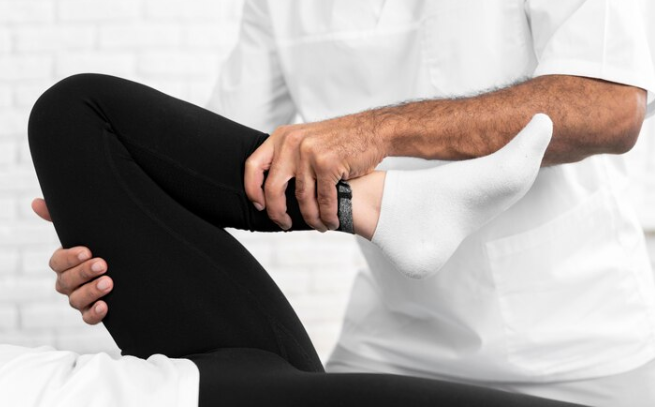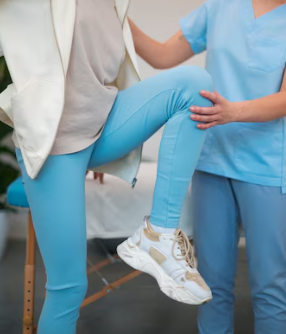A hip replacement can be daunting but with the right information and preparation, you can make the recovery very smooth. In this blog we’ll describe the essentials you should know before, during, and after your surgery, and the importance of Physiotherapy Treatment throughout the process. If you are worried about your upcoming surgery, read on to ease your fears!
What is a hip replacement?
A total hip replacement, or Total Hip Arthroplasty (THA), is a procedure that replaces damaged bone and cartilage and replaces it with prosthetic components. Specifically, there are two techniques.
- Cemented: For more elderly populations or patients who have more sedentary life
style - Uncemented: For a younger population or patients that have a more active lifestyle
Usually, an uncemented style is preferred as it usually results in more natural movement of the hip and less complications after the surgery. However, it takes a lot longer to heal than a cemented technique. Usually, it takes about 3+ months for there to be a strong fixation between the implant and the bone, whereas cemented is almost instantaneous at the sacrifice of future mobility.
Physiotherapy rehabilitation before the surgery
You may have been seeing a Physiotherapist prior to the surgery to maximize your function, strength, and mobility. In some cases, Physiotherapy Treatment can delay or even remove the necessity of a hip replacement! However, in the cases where we know surgery is inevitable, Physiotherapy Treatment helps you preserve and “prehab” the hip to ensure you come out of the surgery as easily as possible. In this case, treatment may include:
- Manual therapy for pain relief and mobility
- Other pain-relieving strategies like electrotherapy, cryo and heat therapy
- Therapeutic exercises to maximize your hip’s potential prior to surgery
- Gait and balance training
- Braces, gait aids and other movement strategies to minimize pain and fatigue
Physiotherapy rehabilitation after a hip replacement
Total hip arthroplasties (THAs) are highly effective procedures with a very smooth recovery process these days. Most patients are able to leave the hospital after a day if there are no complications. Furthermore, there can be immediate improvements in function and pain, especially in patients that had severe hip arthritis or hip joint damage prior to the surgery. However, as amazing as the outcomes can be, post-operative rehabilitation is crucial to ensure that you get there.
In the immediate post-operative phase
The immediate post-operative phase begins as soon as you wake up from anesthesia. Initially in the hospital, Physiotherapy starts right away and gets you moving as soon as possible. Hospital Physiotherapy may look like:
- Gentle exercises to promote blood circulation and minimize swelling
- Starting early muscle activation with exercises
- Assessing and preventing complications such as deep vein thrombosis (blood clots)
- Early functional movements such as moving in bed, sitting or standing at the bedside, walking with a gait aid, stairs
- Assessing you for discharge from the hospital and ensuring it is safe for you to return to your home
- Teaching you your hip restrictions (if any, and as indicated by your surgeon)
In the early rehabilitation phase
The early rehabilitation phase spans the first few weeks after surgery. During this period, you will likely be attending an outpatient Physiotherapy clinic. In Ontario, you are entitled to some coverage under OHIP after a THA. Hospitals will give you a referral to Physiotherapy clinics in the area where you may continue your rehab after leaving the hospital. Our clinic, PhysioNow sees many post-operative patients just days after their surgery. In this stage, areas of treatment include:
- Increasing the intensity and difficulty of exercises
- Scar/incision care and how to manage it at home
- Increasing the weightbearing ability of your hip
- Gait, coordination, balance training
- Education on using gait aids like walkers, canes, rollators
- Effective pain management using modalities or manual therapy
Intermediate Rehabilitation Phase
The intermediate phase, typically from 4 to 12 weeks post-surgery, aims to build on the progress made in the early phase. Physiotherapy sessions become more intensive, and the focus shifts to normalizing your strength and mobility and starting to reintroduce activities of your normal life and hobbies that you enjoy. Physiotherapy Treatment may include:
- Incorporating resistance training, weights and functional exercises such as stairs practice
- Cardiovascular training with lower intensity activities including stationary biking, swimming, walking
- Gait training without mobility aids, or swapping to aids that give less support
- Harder balance exercises including dynamic balance with movements, unstable surfaces
- Manual therapy to try to restore full range of motion in the hip
Late Rehabilitation Phase
The late rehabilitation phase, typically beyond 12 weeks post-surgery, focuses on
preparing the patient for a full return to normal activities, high intensity activities and, if applicable, sports. Physiotherapy sessions will include:
- Advanced balance and proprioception exercises mimicking complex movements and environments
- A back to sport plan that will gradually expose you and increase your tolerance to high impact activities ex. running, jumping for basketball or volleyball
- Practice of specific sport skills in the clinic ex. plyometrics, quick direction changes
- Education on how to take care of your hip long-term
Having a hip replacement surgery soon?
Look for PhysioNow! It is important to make sure that your hip is as strong as possible prior to the surgery. After the surgery, your Physiotherapy will be a progressive process tailored to your individual needs. PhysioNow accepts OHIP patients after a hip or knee surgery, and also offers direct billing for extended health care benefits if you need to continue your treatment for longer. We have 10 spacious locations across the GTA from Burlington to Etobicoke and in between. Book with us today for your first assessment and treatment, or a free 15 minute consult!







Leave a Reply